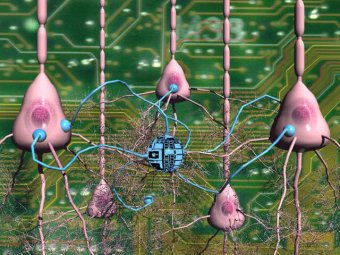Artificial red blood cells, brain aids, and systems for repairing damage in the body are only part of the new science

In the classic science fiction film "Fantastic Voyage", from 1966, a group of scientists is moved to microscopic dimensions in order to sail in a sort of tiny "submarine" inside the bloodstream of a comatose scientist, to penetrate his brain and, like skilled plumbers, fix the necessary repair. Miniaturizing people is completely absurd, but the idea of the tiny "submarine" may come true
- and more than that.
One of the expected products from the developing research in nanotechnologies is medical "nanorobots" (or "nanobots"): tiny tools that will move independently inside the body, locate defects and perform healing operations, starting with the controlled infusion of drugs exactly where needed to the elimination of cancer cells. Nanotechnology deals with building objects from building blocks with dimensions of a nanometer (one millionth of a millimeter), meaning groups of molecules and even individual molecules or atoms. The range of predicted applications includes sophisticated nanoelectronic components (which will enable, for example, supercomputers the size of a sugar cube), materials with strength. Fantastic and other wonderful properties, and perhaps a major revolution in industrial production methods (the distant dream: "nano-assemblers" - a kind of tiny robots that break down materials into molecules and build different products from them).

A drawing of a "brain cell amplifier": millions of octopus-like nanorobots
(in blue), each of which contains a computer and a memory pool, connect to neurons in the brain (in pink) and form an integrated network
In Israel, it was recently announced the establishment of four special research centers for nanotechnologies (at Tel Aviv University, the Technion, the Hebrew University and Ben Gurion University of the Negev). One of the interesting directions that these centers will certainly deal with will be "nano-medicine" - harnessing the nano-technological ability, perhaps in combination with the achievements of genetic engineering, to the service of medicine. This can be seen as a future direction of the development of biomedical engineering.
Prof. Shmuel Einav, who about 25 years ago initiated the establishment of the biomedical engineering major at Tel Aviv University's Faculty of Engineering, points out that this engineering field has recently opened up two fascinating avenues, located on the seam between engineering and biology: tissue engineering and cell engineering. Prof. Einav leads a multi-group research effort whose goal is to understand the interrelationships between the function of cells, blood flow and the behavior of blood vessel walls, and various molecular mechanisms, including the formation of cancer cells.
"Hence the importance of the medical nanorobots", says Einav. "They will detect disturbances in the cell structure and perform corrective actions. In the future, this will lead to 'personalized nanomedicine' - nanorobotic treatment adapted to the biological characteristics of the patient." According to a study by the Center for Technological Forecasting at Tel Aviv University, conducted recently for the Ministry of Science, the first practical "nanobots" are expected at the beginning of the next decade.
An initial design of a medical nanobot was proposed a few years ago by Robert Freitas, a scientist at the American company "Zyvex", which claims to build a prototype of the first "nano-assembler". Freitas' nanobot, which he calls a "respirocyte", is actually a sophisticated artificial blood globule, the size of a bacterium, designed in a spherical crystal structure of a diamond-like material, and functions as a tiny pressure tank containing 9 billion molecules of oxygen and carbon dioxide. When the pellet is injected into the bloodstream, sensors on its surface will measure the level of oxygen and carbon dioxide in the blood. Accordingly, tiny pumps will be activated inside it to take in oxygen in a controlled manner and release carbon dioxide (inside the lungs) or vice versa (in the body tissues).
The nanorobotic globules will, according to Freitas, be much more efficient than natural blood globules: they will store 200 times more gas per unit volume. This will be a huge advantage during a heart attack, for example: a regular supply of oxygen will reach the tissues up to 4 hours from the moment the heart stops functioning. Not to mention the ability to dive in water for 4 hours without needing to breathe.
A more futuristic version of a medical nanobot is a cell repair device, which will replace damaged chromosomes in the cell nucleus with normal chromosomes (prepared in advance from the patient's healthy genes), thus allowing the cell to "reprogram itself" and heal. But even that does not end the creative imagination of the thinkers of futuristic nanomedicine. They foresee super-advanced generations of nano-robots, which will not only cure diseases but also stop tissue aging processes; Nanomotors that will be implanted in muscles and improve physical ability, and multi-armed octopus-like nanocomputers will connect to the network of neurons in the brain and improve memory and thinking ability. If you will, this is the nanotechnological path to the creation of the "cyborg" common in science fiction stories: a human-computer hybrid creation, which some consider the next stage of human evolution.

A drawing of artificial blood cells - perhaps the first generation of medical nanorobots - among natural blood cells. A controlled release of the oxygen stored in the capsule will allow regular oxygen supply hours after a heart attack, and alternatively - hours of diving without breathing
Dr. Hauptman is a senior researcher at the Center for Technological Forecasting at Tel Aviv University

6 תגובות
sparrow
What is written in the article did not happen. At the moment there are modest advances in nanotechnology, it is possible that in a hundred years we will reach the technology that is described.
It's been 10 years, and what happened?